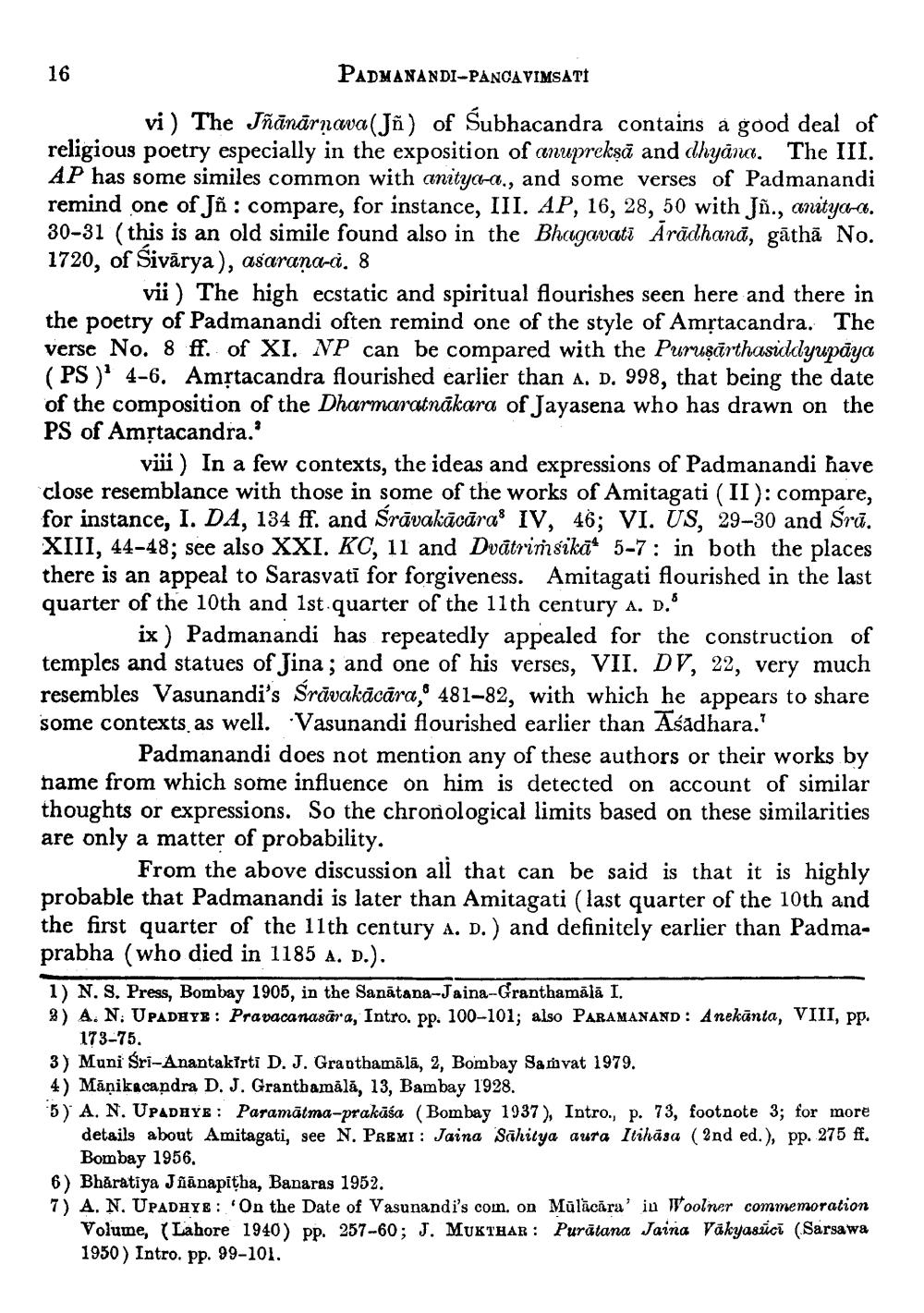________________
16
PADMANANDI-PANCAVIMSATI vi) The Jñānārnava ( Jñ of Subhacandra contains a good deal of religious poetry especially in the exposition of anupreksā and dhyāna. The III. AP has some similes common with anitya-a., and some verses of Padmanandi remind one of Jñ: compare, for instance, III. AP, 16, 28, 50 with Jn., anitya-a. 30-31 (this is an old simile found also in the Bhagavatī Ārādhanā, gāthā No. 1720, of Sivārya), asarana-.. 8
vii) The high ecstatic and spiritual flourishes seen here and there in the poetry of Padmanandi often remind one of the style of Amộtacandra. The verse No. 8 ff. of XI. NP can be compared with the Puruşārthasiddyupāya (PS)' 4-6. Amộtacandra flourished earlier than a. D. 998, that being the date of the composition of the Dharmaratnākara of Jayasena who has drawn on the PS of Amstacandra.'
vü ) In a few contexts, the ideas and expressions of Padmanandi have close resemblance with those in some of the works of Amitagati (II): compare, for instance, I. DA, 134 ff. and Srāvakācāras IV, 46; VI. US, 29-30 and Srā. XIII, 44-48; see also XXI. KC, 11 and Dvátrimsikā* 5-7: in both the places there is an appeal to Sarasvati for forgiveness. Amitagati flourished in the last quarter of the 10th and 1st quarter of the 19th century A. D.
ix) Padmanandi has repeatedly appealed for the construction of temples and statues of Jina ; and one of his verses, VII. DV, 22, very much resembles Vasunandi's Srāvakācāra,* 481-82, with which he appears to share some contexts as well. Vasunandi flourished earlier than Asadhara.
Padmanandi does not mention any of these authors or their works by name from which some influence on him is detected on account of similar thoughts or expressions. So the chronological limits based on these similarities are only a matter of probability.
From the above discussion all that can be said is that it is highly probable that Padmanandi is later than Amitagati (last quarter of the 10th and the first quarter of the 11th century A. D.) and definitely earlier than Padma. prabha (who died in 1185 A. D.). 1) N. S. Press, Bombay 1905, in the Sanātana-Jaina-Granthamälä I. 2) A. N. UPADHYE : Pravacanasāra, Intro. pp. 100-101; also PARAMANAND: Anekānta, VIII, pp.
173-75. 3) Muni Sri-Anantakirti D. J. Granthamālā, 2, Bombay Samvat 1979. 4) Māņikacandra D. J. Granthamälă, 13, Bambay 1928. 5) A. N. UPADAYB: Paramātma-prakāśa (Bombay 1937), Intro., p. 73, footnote 3; for more
details about Amitagati, see N. Premi: Jaina Sāhitya aura Itihasa (2nd ed.), pp. 275 ff.
Bombay 1956. 6) Bhăratiya Jiānapitha, Banaras 1952. 7) A. N. UPADHYE : 'On the Date of Vasunandi's com. on Mülācāra' in Woolner commemoration
Volume, (Lahore 1940) pp. 257-60; J. MUKTHAR: Purätana Jaina Väkyasūcī (Sarsawa 1950) Intro. pp. 99-101.




